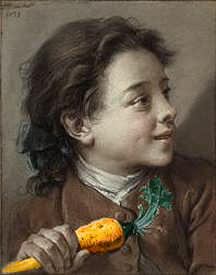2.28.2007
 I'm glad that I posted about drawball the other day, because that prompted Paul Fisher, one of the creative brains behind The One Million Masterpiece to tip us off to his fantastic project. This online project is too good to get lost in the comments section. On the surface, OMM is very similar to Drawball - both are interesting experiments in a participatory, online, unregulated, collaborative, public art project. You can contribute a small piece, or work with others to integrate your art into larger sections. However, below the surface, there are significant differences:
I'm glad that I posted about drawball the other day, because that prompted Paul Fisher, one of the creative brains behind The One Million Masterpiece to tip us off to his fantastic project. This online project is too good to get lost in the comments section. On the surface, OMM is very similar to Drawball - both are interesting experiments in a participatory, online, unregulated, collaborative, public art project. You can contribute a small piece, or work with others to integrate your art into larger sections. However, below the surface, there are significant differences:
First of all, and most importantly, the proceeds from this project go to important charities; Save the Children, Oxfam, Action Aid, World Cancer Research Fund, and the World Wildlife Fund. You don't have to pay-to-play, feel free to draw and go home, but to 'join' the OMM project you can make a donation to the causes- and why not?
There is also an interesting difference in the dynamic of Drawball and OMM, which would be an interesting discussion for any art class interested in collaborative art and new media. Drawball is constantly changing and mutating because every pixel is constantly up for grabs. OMM, on the other hand, provides a small square that can also be regularly changed, but by only one person. Why does is this slight difference so interesting to me? Largely because both sites represent a new level of artistic collaboration which wasn't even remotely possible in recent history, and the projects which have a similar interface and concept, have a radically different result.
From the OMM website:The project is partly an experiment, to see whether artistic collaboration is possible, and what will be its result on such a large scale. We simply do not know whether the end result will be one coherent image, or a patchwork of many different themes, or simply a collection of unrelated individual artworks. Whatever happens, this will be a truly democratic piece of artwork with no "right" or "wrong" answer .
The neat thing about projects like this - very Web 2.0 - is that they show how the internet is very much the realization of something that many of us have always believed - that art is for everyone and belongs to the people, and not limited to musuem walls. Essentially, the picture will represent the defining achievement of online communication - to level traditional hierarchies and give real people a voice.
Thanks for the heads-up, Paul!
Tags: Activism, Collaborative, Digital Art, Pedagogy














